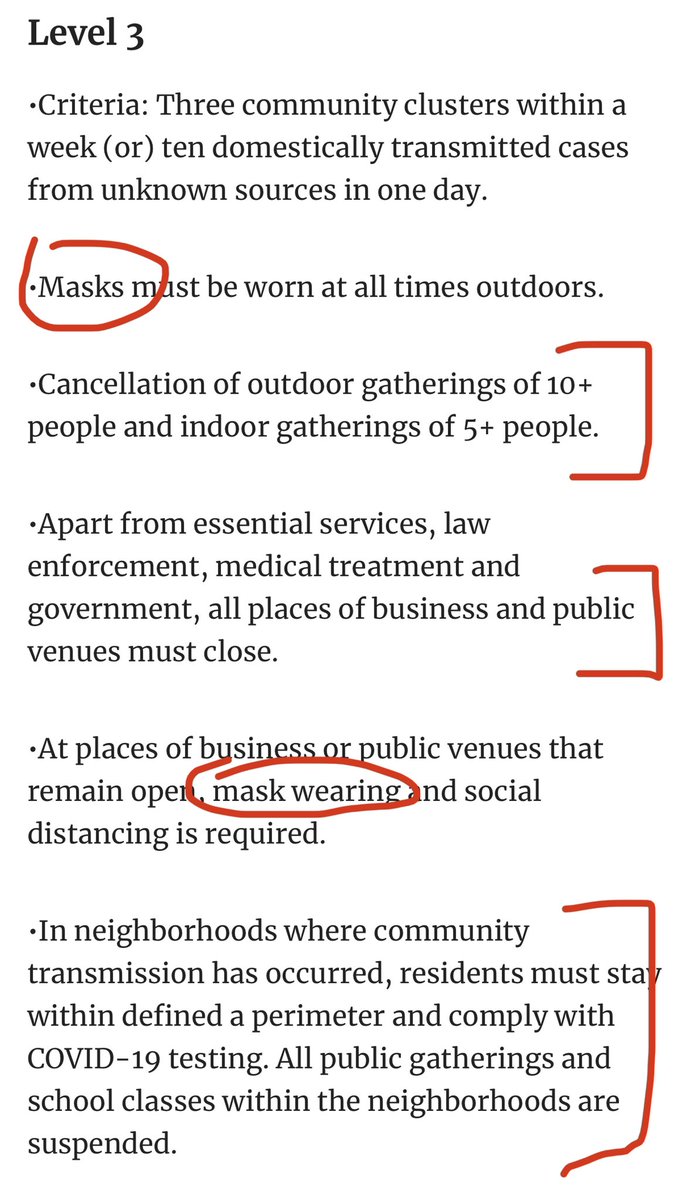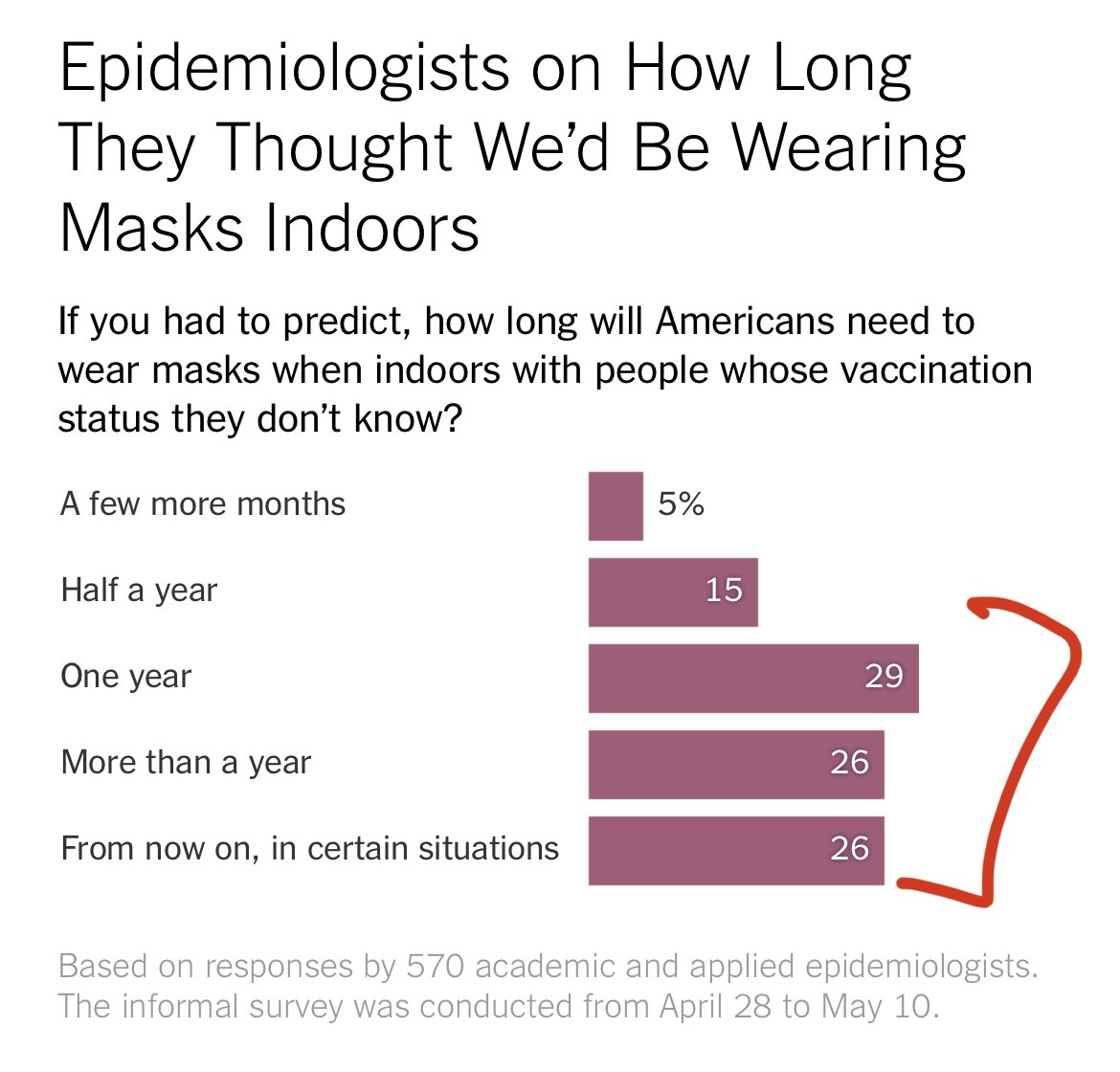
Familiar? 80 years ago—one man (Wells) discovered viruses were airborne & UV light led to fewer sick kids. He was dismissed at the time—by chief epidemiologist of the CDC. The CDC panned the idea measles was airborne for many decades. They were dead wrong.
wired.com/story/the-teen…
wired.com/story/the-teen…

2) The distinction between droplet and airborne transmission has enormous consequences. To combat droplets, a leading precaution is to wash hands. To fight infectious aerosols, the air itself is the enemy. In hospitals, that means expensive isolation wards and N95 masks for all.
3) “The books @linseymarr flipped through drew the line between droplets & aerosols at 5 microns. A micron is a unit of measurement equal to one-millionth of a meter. By this definition, any infectious particle <5 microns in diameter is an aerosol; bigger is a droplet.”
4) “The more [@linseymarr] looked, the more she found that number. The WHO and the US Centers for Disease Control and Prevention also listed 5 microns as the fulcrum on which the droplet-aerosol dichotomy toggled.”
5) “There was just one literally tiny problem: “The physics of it is all wrong,” @linseymarr says. That much seemed obvious to her from everything she knew about how things move through air.”
6) “Reality is far messier, with particles much larger than 5 microns staying afloat and behaving like aerosols, depending on heat, humidity, and airspeed. “I’d see the wrong number over and over again, and I just found that disturbing,” @linseymarr says.
7) “The error meant that the medical community had a distorted picture of how people might get sick.”
(Medical school teaches next to nothing about physics of aerosol particles. Virologists and epidemiologists aren’t taught aerosols either unless environmental epidemiologists)
(Medical school teaches next to nothing about physics of aerosol particles. Virologists and epidemiologists aren’t taught aerosols either unless environmental epidemiologists)
8) “A FEW DAYS after the (dreadful) April Zoom meeting with the WHO, Marr got an email from another aerosol scientist who had been on the call, an atmospheric chemist at the University of Colorado Boulder named Jose-Luis Jimenez @jljcolorado…”
9) “@jljcolorado had become fixated on the WHO recommendation that people stay 3 to 6 feet apart from one another. As far as he could tell, that social distancing guideline seemed to be based on a few studies from the 1930s and ’40s.”
10) “But the authors of those experiments actually argued for the possibility of airborne transmission, which by definition would involve distances over 6 feet. None of it seemed to add up.”
11) @linseymarr told @jljcolorado about her concerns with the 5-micron boundary and suggested that their two issues might be linked. If the 6-foot guideline was built off of an incorrect definition of droplets, the 5-micron error wasn’t just some arcane detail.”
12) “It seemed to sit at the heart of the WHO’s and the CDC’s flawed guidance. Finding its origin suddenly became a priority. But to hunt it down, Marr, Jimenez, and their collaborators needed help. They needed a historian.”
13) …Virginia Tech scholar named Tom Ewing @EThomasEwing specialized in the history of tuberculosis and influenza. They talked. He suggested they bring on board a graduate student he happened to know who was good at this particular form of forensics. The team agreed.”
14) “an email from @EThomasEwing arrived in @katierandall’s inbox describing @linseymarr’s quest and the clues her team had so far unearthed, which were “layered like an archaeology site, with shards that might make up a pot,” he wrote. That did it. She was in.”
15) “Randall had studied citation tracking, a type of scholastic detective work where the clues aren’t blood sprays and stray fibers but buried references to long-ago records. She started digging where Li and the others had left off—with various WHO and CDC papers.
16) “[@katierandall] scrolled and scrolled until she reached the earliest document on tuberculosis prevention that mentioned aerosol size. It cited an out-of-print book written by Harvard engineer William Firth Wells. Published in 1955, called Airborne Contagion and Air Hygiene.”
17) “In the words of Wells’ manuscript, she found a man at the end of his career, rushing to contextualize more than 23 years of research. She started reading his early work, including one of the studies @jljcolorado had mentioned…”
18) “In 1934, Wells and his wife, Mildred Weeks Wells, a physician, analyzed air samples and plotted a curve showing how the opposing forces of gravity and evaporation acted on respiratory particles.
19) “The couple’s calculations made it possible to predict the time it would take a particle of a given size to travel from someone’s mouth to the ground. According to them, particles bigger than 100 microns sank within seconds. Smaller particles stayed in the air.
20) “@katierandall paused at the curve they’d drawn. To her, it seemed to foreshadow the idea of a droplet-aerosol dichotomy, but one that should have pivoted around 100 microns, not 5.” ⚠️!!!
21) “The book was long, >400 pages, and @katierandall was still on the hook for her dissertation. She was also helping her 6-year-old navigate remote kindergarten. late at night, after everyone had gone to bed, she returned to taking detailed notes about each day’s progress.”
22) “One night @katierandall read about experiments Wells did in the 1940s in which he installed air-disinfecting ultraviolet lights inside schools. In the classrooms with UV lamps installed, fewer kids came down with measles.” (NOTE: CDC now does recognize UV to be effective)
https://twitter.com/drericding/status/1365678603212648461
23) “He concluded that the measles virus must have been in the air. @katierandall was struck by this. She knew that measles didn’t get recognized as an airborne disease until decades later. What had happened?”
24) “Part of medical rhetoric is understanding why certain ideas take hold & others don’t. @katierandall started to investigate how Wells’ contemporaries perceived him. That’s how she found writings of Alexander Langmuir, influential chief epidemiologist of newly established CDC.
25) “Like his peers, Langmuir had been brought up in the Gospel of Personal Cleanliness, an obsession that made handwashing the bedrock of US public health policy….”
26) “He seemed to view Wells’ ideas about airborne transmission as retrograde, seeing as a slide back toward an ancient, irrational terror of bad air—the “miasma theory” that prevailed for centuries. Langmuir dismissed them as little more than “interesting theoretical points.”
27) “But at the same time, Langmuir was growing increasingly preoccupied by the threat of biological warfare. He worried about enemies carpeting US cities in airborne pathogens. In March 1951, just months after the start of the Korean War…
28) “Langmuir published a report in which he simultaneously disparaged Wells’ belief in airborne infection and credited his work as being foundational to understanding the physics of airborne infection.
How curious, Randall thought. She kept reading.”
How curious, Randall thought. She kept reading.”
29) “In the report, Langmuir cited a few studies from the 1940s looking at the health hazards of working in mines and factories, which showed the mucus of the nose and throat to be exceptionally good at filtering out particles bigger than 5 microns.”
30) “If someone wanted to turn a rare and nasty pathogen into a potent agent of mass infection, Langmuir wrote, the thing to do would be to formulate it into liquid that could be aerosolized into particles <5 microns, small enough to bypass body’s main defenses. Curious indeed”👀
31) Wells “designed a study using tuberculosis-causing bacteria. The bug was hardy and could be aerosolized, and if it landed in the lungs, it grew into a small lesion. For days, @katierandall worked like this—going back and forth between Wells and Langmuir”
32) “As she got into Langmuir’s later writings, she observed a shift in his tone. In articles he wrote up until the 1980s, toward the end of his career, he admitted he had been wrong about airborne infection. It was possible.” ⚠️ Langmuir was wrong all those decades.
33) “A big part of what changed Langmuir’s mind was one of Wells’ final studies. Working at a VA hospital in Baltimore, Wells and his collaborators had pumped exhaust air from a tuberculosis ward into the cages of about 150 guinea pigs on the building’s top floor.”
34) “Month after month, guinea pigs came down with tuberculosis. Still, public health authorities were skeptical. They complained that the experiment lacked controls. So Wells’ team added another 150 animals, but this time they included UV lights to kill any germs in the air.
35) “Those guinea pigs stayed healthy. That was it, the first incontrovertible evidence that a human disease—tuberculosis—could be airborne, and not even the public health big hats could ignore it.”
36) “The groundbreaking results were published in 1962. Wells died in September of the following year. A month later, Langmuir mentioned the late engineer in a speech to public health workers.
37) “It was Wells, he said, that they had to thank for illuminating their inadequate response to a growing epidemic of tuberculosis. He emphasized that the problematic particles—the ones they had to worry about—were smaller than 5 microns.
38) “Inside @katierandall’s head, something snapped into place. She shot forward in time, to that first tuberculosis guidance document where she had started her investigation.
39) “She had learned from it that tuberculosis is a curious critter; it can only invade a subset of human cells in the deepest reaches of the lungs. Most bugs are more promiscuous. They can embed in particles of any size and infect cells all along the respiratory tract.”
40) “What must have happened, @katierandall thought, was that after Wells died, scientists inside CDC conflated his observations. They plucked the size of particle that transmits tuberculosis out of context, making 5 microns stand in for a general definition of airborne spread.”
41) “Wells’ 100-micron threshold got left behind. “You can see that the idea of what is respirable, what stays airborne, and what is infectious are all being flattened into this 5-micron phenomenon,” @katierandall says.”
42) “Over time, through blind repetition, the error sank deeper into the medical canon. The CDC did not respond to multiple requests for comment.” 🤷🏻♂️
43) “In June, @katierandall Zoomed into a meeting with the rest of the team to share what she had found. @linseymarr almost couldn’t believe someone had cracked it. “It was like, ‘Oh my gosh, this is where the 5 microns came from?!’” After all these years, she finally had answer.
44) “But getting to the bottom of the 5-micron myth was only the first step. Dislodging it from decades of doctrine would mean convincing 2 of the world’s most powerful health authorities not only that they were wrong but that the error was incredibly—and urgently—consequential.”
• • •
Missing some Tweet in this thread? You can try to
force a refresh










